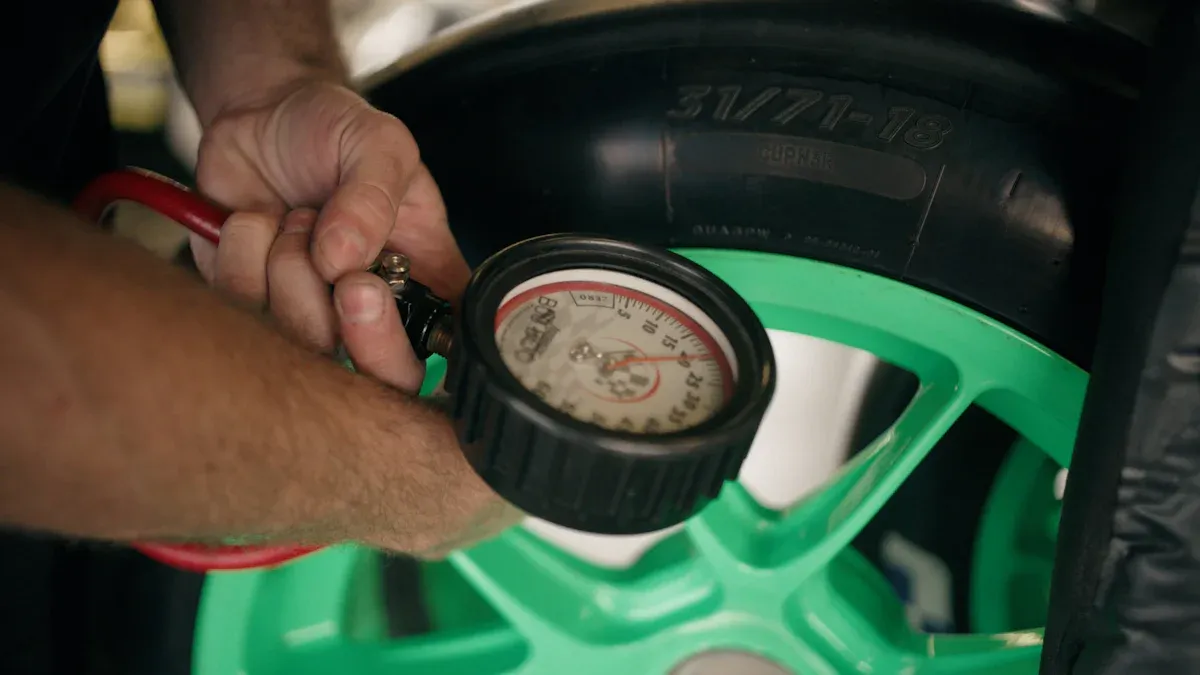レーザー式と機械式のタイヤ溝深さ測定ツールを選ぶ際には、何が必要かを考えましょう。包括的な購入ガイドは、その違いを理解するのに役立ちます。レーザーツールは正確で迅速な測定を提供するため、プロフェッショナルに最適です。一方、機械式ツールはシンプルで信頼性が高く、日常的なユーザーに最適です。どちらのツールを選んでも、溝の深さを測定することは安全のために非常に重要です。 11件に1件の事故はタイヤの問題が原因で発生していますこれは、十分な溝の深さを確保することの重要性を示しています。さらに、溝の深さが減少すると、停止距離が長くなり、車両の性能に影響を与える可能性があります。
重要なポイント
タイヤの溝の深さをチェックすることは、安全のために非常に重要です。古いタイヤによる事故を防ぐのに役立ちます。
レーザーツールは 迅速かつ正確な測定を提供します。精度を必要とする専門家にとって最適です。
機械式ツールは使いやすく、信頼性があります。溝の深さを時々チェックする一般ユーザーに適しています。
溝の深さを頻繁にチェックすることで、車両の性能を向上させることができます。また、より速く停止できるようになり、安全性が向上します。
ニーズに合ったツールを選びましょう 速度と精度を求めるならレーザーツール、使いやすさと低コストを求めるなら機械式ツールが適しています。
タイヤ溝深さ測定ツール概要
タイヤ溝深さ測定ツールは、タイヤの溝の深さをチェックするものです。これらのツールは、タイヤに安全な運転のための十分な溝があるかどうかを確認するのに役立ちます。あなたは見つけることができます さまざまな種類のタイヤ溝深さゲージ 今日。主なタイプを簡単に見てみましょう。
タイヤ溝深さゲージの種類 |
|---|
デジタルタイヤ溝深さゲージ |
手動タイヤ溝深さゲージ |
機械式タイヤ溝深さゲージ |
レーザータイヤ溝深さゲージ |
溝の深さを測定することは、多くの理由で重要です。まず、運転がより安全になります。深い溝は 濡れた雪道や氷の上でもしっかりとグリップ. これによりスリップや事故の可能性が低くなります。第二に、十分なトレッドの深さは停止距離の短縮に役立ちます。良いトレッドのタイヤは特に緊急時に素早く停止します。
定期的にタイヤのトレッド深さを確認することのさらなる利点をいくつか紹介します:
タイヤのトレッド深さを頻繁に確認することは、トラクションとコントロールを維持するための鍵です。
十分なトレッド深さは、良好なブレーキと加速にとって重要です。
トレッド深さが低いと停止距離が長くなり、ハンドリングも悪化するため、大きな安全上の問題となります。
また、より深いトレッドはハイドロプレーニングのリスクを低減します。水を接地面から排除し、濡れた路面でもトラクションを維持します。最後に、タイヤのトレッド深さを監視することで燃料節約にもつながります。摩耗した低トレッドのタイヤは転がり抵抗が増え、より多くの燃料を消費します。
レーザートレッド深さ測定器

レーザートレッド深さ測定器は特殊な技術を用いてタイヤのトレッドの深さを測定します。これらのツールにはハンドヘルドのレーザーが搭載されており、トレッド全体の表面をスキャンします。これにより、非常に正確な測定値(多くの場合0.1mmまで)を提供できます。この技術はラインレーザーを使用してタイヤ表面からデータを収集し、トレッドの摩耗状況を完全に把握します。
レーザートレッド深さ測定器の主な特徴は次の通りです:
特徴 | 説明 |
|---|---|
測定精度 | 最大0.1mm |
測定タイプ | トレッド全体の表面測定および溝単位の測定 |
使用技術 | ラインレーザーを用いたハンドヘルドのトレッド深さレーザー検出器で、トレッド全体をスキャン |
構造設計 | シャーシの高さに制限されない |
レーザー工具を使用することの多くの利点:
より高い精度: レーザー工具はより正確です タイヤの溝深さを測定する際に非常に重要な安全性のために。
効率性: 機械的な工具よりも迅速にタイヤをチェックできるようにします。
人的ミスの削減: レーザー工具の高度な機能が測定中のミスを減らすのに役立ちます。
実際、レーザースキャナーはダイヤルゲージよりも九割の確率で正確です。0.1mmの摩耗も見つけることができ、タイヤの安全性を保つために重要です。古いペニーテストから新しいレーザー技術への移行は、技術の進歩が安全性を向上させたことを示しています。
しかし、レーザー工具にはいくつかの欠点もあります。考慮すべき制限点をいくつか挙げます:
三角測量法 は、溝やひび割れのように深さが突然変化する表面には問題が生じることがあります。
タイヤの表面形状を確認するのは、深い溝や薄い部分が測定を難しくするため難しい場合があります。
表面に直接接触する方法は、同様の問題に直面します。
これらの制限があっても、レーザーテ tread深さ測定工具は、専門家だけでなく一般ユーザーにも依然として人気があります。迅速かつ正確な測定能力が、タイヤのメンテナンスにとって優れたツールとなっています。
購入を検討している方には、2025年のレーザーテ tread深さ測定工具の平均価格は、 $449.00 Autel MaxiTPMSレーザー対応タイヤトレッド深さ測定工具と$506.00のAutel MaxiTPMS TBE200Eタイヤブレーキ検査器の間です。
機械式タイヤトレッド深さ測定工具

機械式タイヤトレッド深さ測定工具 は、タイヤの溝の深さを測るシンプルな装置です。通常、溝に挿入するプローブが付いており、その後アナログスケールから測定値を読み取ります。これにより、特別な技術を必要としないため、日常的なドライバーにとって使いやすいです。
機械式工具の主な特徴
こちらが デジタルまたはレーザー工具と比較した場合の:
特徴 | 機械工具 | デジタル/レーザー工具 |
|---|---|---|
使いやすさ | プローブを挿入して手動で読み取る | 自動測定値を提供することが多い |
表示タイプ | アナログスケールで測定値を表示 | 数字が表示されるデジタル表示 |
測定方法 | プローブを使って手動で測定 | レーザーや電子的方法を使用 |
光条件 | 見やすくするために色が付いている場合がある | 低照度環境での方が読みやすいことが多い |
機械工具の利点
機械式タイヤトレッド深さ測定工具を使用することには多くの利点がある:
安全性の確保: 定期的にタイヤのトレッド深さを確認することが 摩耗したタイヤによる事故を防ぐのに役立つ.
車両性能: 十分なトレッド深さを保つことが より良いブレーキとハンドリングに役立ち運転をよりスムーズにする。
ハイドロプレーニング防止: 良いトレッド深さは濡れた道路でのハイドロプレーニングの可能性を低減します。
機械工具の欠点
機械工具は便利ですが、いくつかの欠点もあります:
手動操作: プローブを挿入して自分で読む必要があり、自動工具よりも簡単ではない場合があります。
精度の低さ: 機械工具はレーザー工具ほど正確ではないことがあります。特に摩耗が激しいタイヤの場合はそうです。
ボントレガータイヤトレッド深さ計は一貫した測定結果を提供します. これにより、タイヤの摩耗がほぼ進んでいる時期を知ることができます。この信頼できる測定は、タイヤの安全性と性能を維持するために重要です。
安全を確保し、車両の正常な動作を保つために、 定期的にタイヤのトレッド深さを点検してください. 正確な測定には良いタイヤトレッド深さ計を使用してください。摩耗バーと同じ深さになったらタイヤを交換し、良好なグリップを維持しましょう。
精度の比較
レーザーと機械式タイヤトレッド深さ測定工具の選択時には、精度が非常に重要です。 レーザー工具は通常、より正確な測定結果を提供します 機械工具よりも0.1mm以内の測定が可能です。機械工具はしばしば精度が低くなることがあります。この違いは運転中の安全性に大きく影響します。
専門的な場面では高い精度が必要です。例えば、車両管理者は タイヤトレッド深さの規則を守る必要がありますこれらの規則を破ると、車両が運行停止になることがあります。定期的なメンテナンスと正確な測定はリスクを低減し、フリートの利益向上に役立ちます。以下は重要なポイントです:
すべての点検時にタイヤトレッド深さを測定することが良好なメンテナンスの鍵です。これにより、車両の安全性と性能を維持できます。
正確な測定は、タイヤの購入者が運転方法に基づいて賢明な選択をするのに役立ちます。
定期的なタイヤの溝の深さのチェックは 車両の安全性を維持し、良好な性能を発揮するために重要です。
一方、機械式のツールは、時々溝の深さをチェックするカジュアルなユーザーには十分かもしれません。しかし、頻繁に運転したり、厳しい条件下で運転する場合は、レーザーツールを使用すると安全性が向上します。不均一なトレッドの摩耗は危険な運転状況を引き起こす可能性があり、正確な測定が非常に重要である理由を示しています。
結局のところ、 レーザーツールと機械式ツールのどちらを選ぶか は、必要なものによって異なります。精度と速度を求めるなら、レーザーツールが最適です。簡単なチェックには、機械式ツールでも十分に機能します。
使いやすさ
使いやすさについて考えると、レーザー式と機械式のタイヤ溝深さ測定ツールは異なった感触です。
レーザーツールによるユーザーエクスペリエンス
レーザーツールは 非常に使いやすくなりました。多くの人がこれらのツールをシンプルでわかりやすいと感じています。ユーザーがどのように感じているかについての重要なポイントをいくつかご紹介します。
新しいレーザーセンサーは より小型で扱いやすくなっています.
ユーザーは フレンドリーなインターフェース を気に入っており、迅速かつ正確な測定を支援します。
タッチスクリーンやリアルタイムのデータ表示などの機能により、使いやすくなっています。
レーザーセンサーはタイヤの深さをより速く、より正確に検出するのに役立つため、使いこなせるようになります。
これらの改善により、新しいユーザーでも混乱することなくレーザーツールを使い始めることができます。
機械工具を使ったユーザーエクスペリエンス
機械工具は異なる体験を提供します。シンプルさが好まれることが多いです。こちらが期待できることです:
プローブをトレッドの溝に入れて、自分で測定値を読むことができます。
アナログスケールは見やすく、誰でも理解しやすいです。
電池や複雑な設定が不要なので、メンテナンスが少なくて済みます。
機械工具はシンプルですが、正確な測定値を得るためには少し注意が必要です。正しい数値を得るために、プローブを入れるときに注意してください。
メンテナンスと耐久性
タイヤのトレッド深さ測定工具の手入れは非常に重要です。これにより、長持ちし、正確に動作します。各タイプの工具には異なるケアが必要です。
レーザーツールのメンテナンス必要性
レーザーツールは適切に使用しないと正常に動作しません。良好な状態を保つための重要なポイントをいくつか紹介します:
工具に水を近づけないでください。 水は内部の部品にダメージを与える可能性があります。
油の付いた手で工具に触れないでください。 油はセンサーの動作に影響を与える跡を残すことがあります。
定期的にアルコールで工具を拭いてください。 これにより表面が清潔で汚れがつきにくくなります。
スクリーンプロテクターを使用して傷を防いでください。 傷ついた画面は測定値の視認性を低下させます。
これらのポイントを守ることで、レーザーツールを正確な測定に備えることができます。
機械工具のメンテナンス必要性
機械工具は扱いやすいですが、注意も必要です。お手入れの方法は次のとおりです:
プローブを頻繁に掃除してください。 汚れは測定の正確さを変えることがあります。
工具は乾燥した場所に保管してください。 湿気は錆や損傷の原因となることがあります。
摩耗の兆候を確認してください。 目盛りが見にくい場合は、新しい工具の購入を検討してください。
機械工具は丈夫ですが、手入れを怠ると誤った測定結果につながることがあります。定期的な点検で早期に問題を発見できます。
顧客のレビューと体験談
読むとき 顧客のレビューを見ると、レーザーと機械式タイヤトレッド深さ測定工具のさまざまな体験がわかります。
レーザー工具に対する好意的な意見
多くのユーザーは、その正確さとスピードを理由にレーザー工具を好んでいます。以下は一般的なポイントです:
迅速な測定: ユーザーは測定結果が非常に速く得られる点を気に入っています。このスピードは忙しい作業場で特に役立ちます。
高い精度: 顧客は測定の正確さについてよく話します。トレッド深さの測定結果に自信を持っています。
使いやすいデザイン: 多くの人がインターフェースの使いやすさを評価しています。タッチスクリーンなどの機能が操作を簡単にしています。
機械工具に関する肯定的なフィードバック
機械工具も良いレビューを受けています。ユーザーがそれらを楽しむ理由は次のとおりです:
シンプルさ: ユーザーはシンプルなデザインを好みます。プローブの挿入やスケールの読み取りが簡単だと感じています。
耐久性: 多くの顧客は機械工具が長持ちすると述べています。頻繁な使用に耐える頑丈な作りを評価しています。
電池不要: ユーザーはこれらの工具が電池を必要としないことを楽しんでいます。これにより、いつでも電源を気にせず使用できます。
ユーザーからの一般的な不満点
良い点がある一方で、一部のユーザーには懸念もあります。以下は一般的な不満点です:
精度の低さ: 一部のユーザーは機械工具は正確でないと考えています。特に摩耗したタイヤで誤った測定値を心配しています。
手動操作: ユーザーは手動の作業が退屈だと感じることもあります。レーザーツールの自動機能を好みます。
較正の問題: 一部の顧客は、機械工具は時間とともにずれることがあると述べています。定期的に点検して正確さを保つことを推奨しています。
これらのレビューを見ることで、賢い選択ができます。レーザー工具と機械工具のどちらを選ぶにしても、ユーザーの経験を知ることはあなたのニーズに合ったものを見つけるのに役立ちます。
このバイヤーズガイドでは、レーザーと機械のタイヤトレッド深さ測定工具の違いについて学びました。レーザー工具は非常に正確で迅速な測定を行い、専門家にとって最適です。高度な技術を使用していますが、価格が高くなることもあります。機械工具はシンプルで安価ですが、正確さは劣る場合があります。時々タイヤのトレッド深さを確認するカジュアルなユーザーに適しています。
工具を選ぶときは、自分の必要に応じて考えてください。正確さとスピードを重視するならレーザー工具を選びましょう。使いやすさとコストを抑えたいなら、機械工具が良い選択です。
よくある質問
安全運転のための理想的なトレッド深さは何ですか?
最低でも2/32インチのトレッド深さを維持してください。この深さは、特に濡れた路面での適切なグリップを確保するのに役立ちます。定期的にタイヤを点検して安全性を保ちましょう。
安全運転のためには、少なくとも2/32インチの溝深さが必要です。ただし、多くの専門家は、特に濡れた条件下では、溝深さが4/32インチに達したらタイヤを交換することを推奨しています。
タイヤの溝の深さを少なくとも月に一度は確認してください。長距離ドライブの前にも点検しましょう。定期的な点検は摩耗を早期に発見し、安全性を維持するのに役立ちます。
ペニー硬貨を使って溝の深さを測ることはできますか?
はい、ペニー硬貨を使った簡易テストが可能です。リンカーンの頭部が下向きになるように硬貨を溝に差し込みます。頭部の上部が見える場合は、溝が摩耗しすぎているのでタイヤを交換してください。
レーザーツールは投資価値がありますか?
レーザーツールは高い精度と速度を提供し、専門家にとって理想的です。頻繁に溝の深さを点検したり、車両の管理を行ったりする場合、レーザーツールへの投資は安全性と効率性を向上させることができます。
機械式の溝深さ測定ツールのメンテナンス方法は?
機械式ツールは清潔で乾燥した状態を保ちましょう。定期的にプローブの汚れを確認し、スケールが読み取れることを確かめてください。適切なケアは精度を維持し、ツールの寿命を延ばします。






